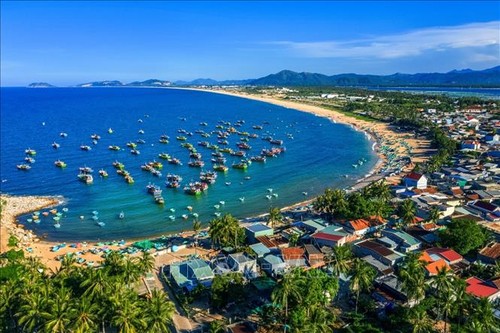 Xuan Hai fishing port in Song Cau town, Phu Yen province (File photo: Chau Dao Cuong/VNA) Xuan Hai fishing port in Song Cau town, Phu Yen province (File photo: Chau Dao Cuong/VNA) |
The National Marine Spatial Planning was developed by the Department of Vietnam’s Seas and Islands of the Ministry of Natural Resources and Environment, to orient the exploitation and use of marine and island resources sustainably, synchronize the country's development planning system, promote socio-economic development, protect the environment and ecosystems, and maintain national independence, sovereignty, sovereign rights, jurisdiction, and national interests at sea.
Maximizing the potential of marine economic development
Vietnam has a coastline of over 3,260km and its territorial waters under its sovereignty, sovereign rights, and jurisdiction cover more than 1 million square kilometers, an area that includes Hoang Sa (Paracel) and Truong Sa (Spratly) archipelago and more than 3,000 other islands and archipelagos.
With more than half of its population living in its 28 coastal provinces and cities, Vietnam has a huge potential for developing a marine economy, including marine transportation, mineral exploitation and processing, seafood exploitation and processing, and marine tourism.
The National Marine Spatial Planning contributes to the implementation of Party and State policies for managing seas and islands and sustainably developing a marine economy.
The Planning will be regularly revised and supplemented to integrate with national development. The Planning has drawn on the opinions of experts at universities and research institutes and information from the ministries and sectors of the 28 coastal cities and provinces.
It has zoned off marine spaces based on ecosystems and connections with the mainland in coordination with national security, defense, external affairs, and international cooperation.
 Le Minh Ngan, Deputy Minister of Natural Resources and Environment Le Minh Ngan, Deputy Minister of Natural Resources and Environment |
Le Minh Ngan, Deputy Minister of Natural Resources and Environment, said: “The Planning is an important legal basis for the management of marine resources in association with other economic sectors to promote the potential and advantages of localities. The planning is developed on the principles of ensuring the Party's policies, socio-economic development, national security and defense, and international integration and sustainable development environment.”
Effective tool for marine spatial management
Vietnam considers marine spatial planning essential to make Vietnam a strong and rich maritime country. The National Marine Spatial Planning integrates with other planning projects to create drivers for socio-economic development, culture, environmental protection, marine conservation, and national defense and security.
The Planning aims to ensure sustainable development on the foundation of green growth, maintain harmony between conservation and development, maximize the potential of every industry and locality, and serve marine environment and seabed minerals research.
Phan Xuan Thuy, Deputy Head of the Party Central Committee’s Commission for Communication and Education, said: “Marine spatial planning is important for coastal countries. It’s an important tool to realize the national master plan toward the goal of all Vietnam's maritime zones being effectively managed and sustainably used, meeting the requirements of socio-economic development, national defense, and security, in alignment with natural socio-economic conditions, and national resilience and capacity. It serves the goal of making Vietnam a rich, strong maritime country.”
Resolution of the 8th session of the 12th Party Central Committee on “Strategy for sustainable development of Vietnam's marine economy to 2030, with a vision to 2045" sets oversal and specific goals to turn Vietnam into a strong maritime country.
By 2030, Vietnam’s marine economic sectors will contribute about 10% of GDP and its 28 coastal provinces and cities will contribute 65-70% of GDP.